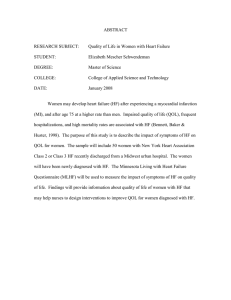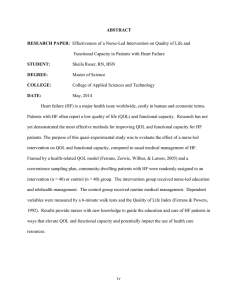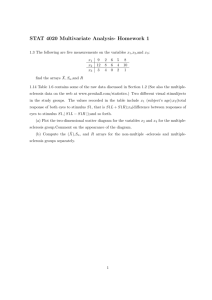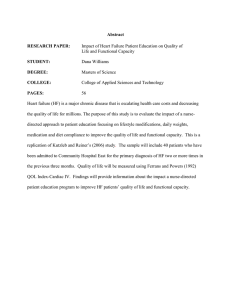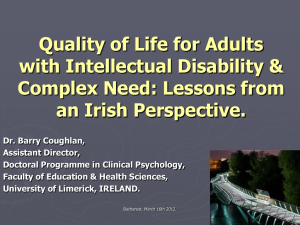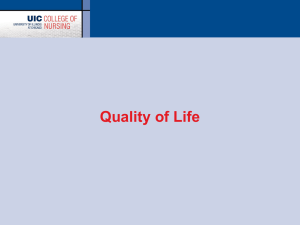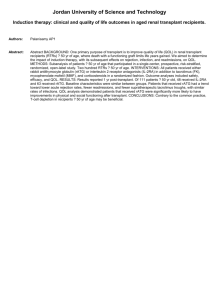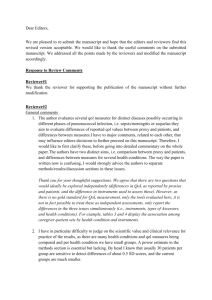Quality of Life of Teachers of Children with Disabilites
advertisement
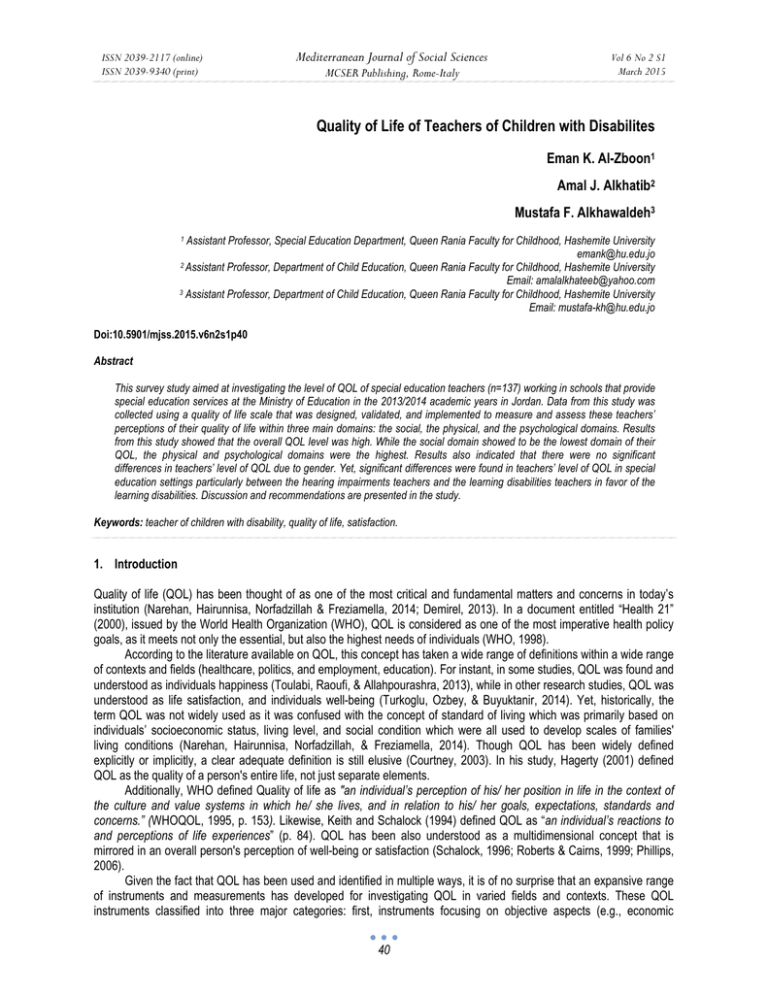
ISSN 2039-2117 (online) ISSN 2039-9340 (print) Mediterranean Journal of Social Sciences MCSER Publishing, Rome-Italy Vol 6 No 2 S1 March 2015 Quality of Life of Teachers of Children with Disabilites Eman K. Al-Zboon1 Amal J. Alkhatib2 Mustafa F. Alkhawaldeh3 Assistant Professor, Special Education Department, Queen Rania Faculty for Childhood, Hashemite University emank@hu.edu.jo 2 Assistant Professor, Department of Child Education, Queen Rania Faculty for Childhood, Hashemite University Email: amalalkhateeb@yahoo.com 3 Assistant Professor, Department of Child Education, Queen Rania Faculty for Childhood, Hashemite University Email: mustafa-kh@hu.edu.jo 1 Doi:10.5901/mjss.2015.v6n2s1p40 Abstract This survey study aimed at investigating the level of QOL of special education teachers (n=137) working in schools that provide special education services at the Ministry of Education in the 2013/2014 academic years in Jordan. Data from this study was collected using a quality of life scale that was designed, validated, and implemented to measure and assess these teachers’ perceptions of their quality of life within three main domains: the social, the physical, and the psychological domains. Results from this study showed that the overall QOL level was high. While the social domain showed to be the lowest domain of their QOL, the physical and psychological domains were the highest. Results also indicated that there were no significant differences in teachers’ level of QOL due to gender. Yet, significant differences were found in teachers’ level of QOL in special education settings particularly between the hearing impairments teachers and the learning disabilities teachers in favor of the learning disabilities. Discussion and recommendations are presented in the study. Keywords: teacher of children with disability, quality of life, satisfaction. 1. Introduction Quality of life (QOL) has been thought of as one of the most critical and fundamental matters and concerns in today’s institution (Narehan, Hairunnisa, Norfadzillah & Freziamella, 2014; Demirel, 2013). In a document entitled “Health 21” (2000), issued by the World Health Organization (WHO), QOL is considered as one of the most imperative health policy goals, as it meets not only the essential, but also the highest needs of individuals (WHO, 1998). According to the literature available on QOL, this concept has taken a wide range of definitions within a wide range of contexts and fields (healthcare, politics, and employment, education). For instant, in some studies, QOL was found and understood as individuals happiness (Toulabi, Raoufi, & Allahpourashra, 2013), while in other research studies, QOL was understood as life satisfaction, and individuals well-being (Turkoglu, Ozbey, & Buyuktanir, 2014). Yet, historically, the term QOL was not widely used as it was confused with the concept of standard of living which was primarily based on individuals’ socioeconomic status, living level, and social condition which were all used to develop scales of families' living conditions (Narehan, Hairunnisa, Norfadzillah, & Freziamella, 2014). Though QOL has been widely defined explicitly or implicitly, a clear adequate definition is still elusive (Courtney, 2003). In his study, Hagerty (2001) defined QOL as the quality of a person's entire life, not just separate elements. Additionally, WHO defined Quality of life as "an individual’s perception of his/ her position in life in the context of the culture and value systems in which he/ she lives, and in relation to his/ her goals, expectations, standards and concerns.” (WHOQOL, 1995, p. 153). Likewise, Keith and Schalock (1994) defined QOL as “an individual’s reactions to and perceptions of life experiences” (p. 84). QOL has been also understood as a multidimensional concept that is mirrored in an overall person's perception of well-being or satisfaction (Schalock, 1996; Roberts & Cairns, 1999; Phillips, 2006). Given the fact that QOL has been used and identified in multiple ways, it is of no surprise that an expansive range of instruments and measurements has developed for investigating QOL in varied fields and contexts. These QOL instruments classified into three major categories: first, instruments focusing on objective aspects (e.g., economic 40 ISSN 2039-2117 (online) ISSN 2039-9340 (print) Mediterranean Journal of Social Sciences MCSER Publishing, Rome-Italy Vol 6 No 2 S1 March 2015 conditions and housing); second, instruments focusing on entirely subjective aspects (these focus on a person’s perceptions, such as happiness and life satisfaction), and third, instruments focusing on objective and subjective aspects together (such as the health-related quality of life (HRQL) instruments) (Arnold, 1991; McDowell, 1996). Regardless of all above, there is an agreement that" QOL is a broad-ranging concept, incorporating in a complex way, the person’s physical health, psychological state, level of independence, social relationships, personal beliefs and relationship to salient features of the environment.” (WHOQOL, 1995, p., 153). Research studies available on QOL suggested that there are several factors that seemed to be related to and appeared to be affecting a person’s QOL, some of which may include: job satisfaction (Narehan, Hairunnisa, Norfadzillah & Freziamella, 2014; Onder & Sari, 2009; Fernandes & Rocha, 2009), emotional intelligence (Deniz, Avsaroglu, Deniz, & Bek, 2010), the influence of services available (Barry & Zissi, 1997), age, gender (Skucas & Mockeviciene, 2009; Ozdol, Pinar, Dayanc, & Cetin, 2014); disability conditions (Rimmerman & Crossman, 2004), and teacher trust level in students, parents, colleagues, and the principal (Maele & Houtte, 2012). In this study, attention is paid to the QOL of teachers of special education, as this study acknowledges the important role these teachers have in their students’ lives and on their educational experiences and rehabilitation (Yahia, 2006). For this, we should provide all the means to improve their QOL particularly that special education teachers suffer from and have to deal with several stress resources which could affect their overall well-being (Onder & Sari, 2009; Platsidou & Agaliotis, 2008; Cook & Downing, 2005; Wilson, 2002; Billingsley, 2004; Haughey & Murphy, 2001; Folostina & Tudorache, 2012; Yahia, 2006). If not dealt with properly or prevented, these stress resources could ultimately lead to unhappily devastating outcomes (e.g., feeling emotionally burned-out, quitting work, changing one’s career) (Brown, Howcroft, & Jacobs, 2009; Onder & Sari, 2009; Burn – Moses, 2005). It is apparent from the literature available on QOL that though there have been an increased interest in exploring the concept of QOL in teaching and for teachers, there is still a lack of research presented on QOL of teachers within the field of special education. In one study conducted on 160 elementary school teachers, it was revealed that female teachers had higher general health score among the QOL dimensions. As well, these teachers scored higher on the physical activity level especially for those more physically fitted female teachers in comparison with the male teachers (Ozdol, Pinar, Dayanc, & Cetin, 2014). Locally, Abushaira (2012) explored job satisfaction among Jordanian special education teachers. Results found that the level of job satisfaction among the teachers was moderate. No Significant statistical differences were found in the participants’ level of job satisfaction due to gender. However, significant differences were found in the participants’ level of job satisfaction due to age in favor to younger teachers. In their study, Veldman, Tartwijk, Brekelmans, and Wubbels (2013) examined the development of teacher–student relationships and teachers' job satisfaction. Results indicated that teachers' job satisfaction tended to be positively related to the subjective quality of the teacher–student relationships. In the same manner, Toulabi, Raoufi, and Allahpourashra (2013) conducted a descriptive study to examine the relationship between teachers' happiness and their quality of work life. The results revealed that there is a relationship between the happiness level of teachers and the components of quality of work life, such as payment rate, professional development and promotion opportunities, management support, and participation in decision making. In another study carried out with 406 teachers working in private and public preschools, primary and secondary schools, Demirel (2013) examined the relationship between job- and life satisfaction among teachers. Results indicated that there was a significant correlation between life satisfaction and job satisfaction. Job satisfaction of public teachers and preschool teachers, and life satisfaction of female teachers were higher. Feizabadi, Hamidi, Khatibzadeh, and Ghamati (2012) also investigated the relationship between job stress and the QOL of sport teachers. The results indicated that there were not any statistically significant differences among the job stress with some items of teachers' QOL, such as fair pay, provide growth opportunities, legislation in organization, social dependence of work life, overall life space, social integrity, develop human ability. In a different study conducted by Bassi, Assunção, Medeiros, Menezes, Teixeira, and Gama (2011) to examine the effect of voice on the QOL of teachers. Results revealed there was not any statistically significant relationship among the degree of dysphonia and otorhinolaryngologists ORL diagnosis, the degree of dysphonia, and the QOL level. On the contrary, this study found that there was negative impact of voice on the QOL of females, but these impacts were not connected with ORL diagnosis and level of dysphonia. Furthermore, Deniz, Avsaroglu, Deniz, and Bek (2010) examined the relationships between emotional intelligence and life satisfactions of special education teachers. Results showed that stress management and general mood sub-dimensions have positive relationships with life satisfaction, while surprisingly, intrapersonal skills, interpersonal skills and adaptability sub-dimensions were not found to have any relationships with life satisfaction. 41 ISSN 2039-2117 (online) ISSN 2039-9340 (print) Mediterranean Journal of Social Sciences MCSER Publishing, Rome-Italy Vol 6 No 2 S1 March 2015 To determine the QOL of teachers, Fernandes and Rocha (2009) reported that the general evaluation of QOL showed that the physical and environmental dimensions cited as the lowest domain. Meanwhile, most of the participants rated that they have active work (high demand and control), followed by having demanding work (high demand and little control). In their study, Onder & Sari (2009) examined the rate of how teachers’ perceptions about wellbeing are predicted by their perceptions about the quality of school life and burnout levels. It was found that Teachers’ life satisfaction levels were predicted significantly by items of the Quality of School Life Scale, such as coping work-related stress and school administrator Worldwide, there is an increasing interest on the knowledge economy which focuses on intellectual capital, such as teachers, as a firm's resource of competitive improvement (Rooney, Hearn, & Ninan, 2005). Nationally, within the Jordanian educational context, current era of Educational Reform for Knowledge Economy ERfKE has led to an appreciable focus on student outcomes; this could cause increased stress among teachers. Alongside With current fundamental changes in the our educational system and limited resources supplied by the Ministry of Education MOE, Jordanian teachers might be suffer from greater job related stress, which could affect their physical and mental health and eventually their quality of life. In fact, we cannot insure occurring the educational reforms without considering enhancement process of teachers' QOL. From other hand, in spite of the increasing number of studies investigating QOL, there are no Arabic or local studies studied that have studied this topic. Research of this kind would allow us to better determine the factors influencing the QOL of special education teachers, such as gender, type of disability, and education level. Thus, assessing, examining, and investigating teachers' QOL can greatly increase the decision makers’ understanding of the impact of the teaching on teacher perceptions of well-being and satisfaction. Also, results of such investigation can help guide public policies aimed at promoting the QOL of this group of teachers. Taking into consideration all above and in harmony with the current national educational reforms, the purpose of this study is to examine QOL of special education teachers and the effect of teacher’s gender, education levels, and type of disability (visual impairment, hearing impairments, and learning disabilities) on QOL of special education teachers. Specifically, the current study attempted to answer the following questions: 1- What is the level of the special education teachers' QOL? 2- Does special education teachers' QOL differ due to teacher’s gender, education levels, and type of disability? 2. Method 2.1 Design This research employed a descriptive method design, where a survey was used to gather data about the level of QOL of special education teachers and the effect of teacher’s gender, education levels, and type of disability (visual impairment, hearing impairments, and learning disabilities) on QOL of special education teachers. The survey attempted to explore the different level of QoL and the sublevels included within (i.e. physical, psychological, and social). The collected data by survey helped in drawing a large picture based on a representative sample, and can therefore be generalizable to a population. 2.2 Population and Participants The population of this descriptive survey study included all the male and female teachers from the Ministry of Education MOE who were working in public schools situated in the capital city of Jordan-Amman (N=320) in the academic year of 2013-2014. The sample consisted of a total of 137 special education teachers (32 males and 105 females). Among the 137 teachers, 62 working in mainstreaming schools that provide services for children with learning disabilities were randomly selected. Meanwhile, 33 special education teachers working in 2 special education schools for children with hearing impairments and 42 special education teachers working in 2 special schools for children with visual impairments were purposefully selected. Sample excluded teachers who, for health reasons, were not working during the implementation phase. Table 1 clarifies the distribution of the sample. 42 ISSN 2039-2117 (online) ISSN 2039-9340 (print) Mediterranean Journal of Social Sciences Vol 6 No 2 S1 March 2015 MCSER Publishing, Rome-Italy Table (1) Characteristics of the Sample Participants According to Gender, Type of Disability and Education level. Variable Gender Males Females Type of disability Learning disabilities Visual impairments Hearing impairments Education level Diploma Bachelor Post-graduate studies Years of experience 1-2 3-10 More than 10 N 32 105 62 42 33 26 68 43 26 43 68 2.3 Instrumentation Quality of life scale was developed to identify the level of QOL of special education teacher. This scale, in its final form, consisted of three dimensions, covering (26) items. These dimensions are: physical (1-8), psychological (9-20), and social (21-26). Teachers were asked to choose the answer, which corresponds with their perceptions of QoL levels, at a five point Likert-type scale (1= never, 2= almost never, 3=usually, 4= almost always, 5= always). To establish the content validity of the instrument, eight arbitrators were asked to review the items and provide feedback to authors. Items were revised until there was 100% agreement among the arbitrators on both the content validity and the wording of each item. Also the method of building the scale, its procedures, and the sources from which the items were derived, are considered an additional evidence of the validity of the scale. The reliability of the scale was determined using two methods: first, reliability by test-retest through scale's administration on ten of special education teachers, then it was a administered once again after 15 days. Second, reliability of internal consistency by using Cronbach Alpha. The reliability by test-retest and Cronbach Alpha were (.88) and (.874) respectively, which they were fit for the study purposes and reflecting good levels of consistency. 2.4 Procedures To achieve the aims of the present study, the following procedures were taken: - Based on literature review and different QOL scales, the researchers developed the QOL scale. - The researchers administered the scale of study on an exploratory sample (five of the special education teachers); to be sure of clarity of items and their fitness. Then, the scale of study was amended due to the experiment. The MOE in Jordan was contacted and asked to provide a list of the schools that provide special education services. - The scale of study survey instruments were mailed to participants through their directorate of education of Amman districts. - After the termination of administering the scale, statistical analysis was done, through using the statistical packages of the social science (SPSS), to do the descriptive analysis. Descriptive statistics (e.g., means, and standard deviations) regarding QOL were used. In addition, One-Way analysis of variance (ANOVA) and independent samples t test were used to check for any significant mean differences that could be attributed to: teacher’s gender, education level, and type of disability. 2.5 Ethical considerations Taking ethical considerations into account, official approval for the study was obtained from official authority. All 43 ISSN 2039-2117 (online) ISSN 2039-9340 (print) Mediterranean Journal of Social Sciences Vol 6 No 2 S1 March 2015 MCSER Publishing, Rome-Italy participants were initially contacted, asked to participate in the study and informed about the core and the aims of the research. Participant consent to participate was gained. They were assured of the anonymity of their responses by using pseudonyms to report the results and were guaranteed confidentiality of collected data. This study has been conducted in consistent with the ethics issued by Institutional Review Board (IRB) at the Hashemite University. 3. Results To achieve the aims of study formerly indicated, means and the standard deviations were calculated to the level of quality of life of special education teachers as total scores, and to every dimension of the QOL scale. Dimensions were ranked due to the mean of scores. Table (2) the means and standard deviations for the QOL scale dimensions Dimension Psychological Physical Social The total scale Mean 4.29 4.27 3.97 4.21 Standard Deviation 0.518 0.677 0.656 0.494 Rank 1 2 3 - It is clear from table (2) that the sample's general level of QOL is high, that the general mean is (4.21). Psychological domain rated as the highest domain with mean (4.29), followed by physical domain with mean score (4.27). As well, teachers rated social domain as the lowest domain with mean (3.97). Moreover, t test for independent samples was used to find out the differences in the means scores of scale according to teachers gender (male, female). Result of t test revealed no statistically significant mean differences between male and female on QOL (t=--.348-, p =.394). A one-way ANOVA was used to test the influence of education level on the total QOL variables for the sample. Results of ANOVA statistic revealed no statistically significant differences due to education level on the total QOL variable for teachers (F = 1.368, p =.258). On the other hand, ANOVA revealed significant differences due to type of disability related to QOL for teacher (F = 3.035, p= .0492). To find out the sources of these differences, Tukey test for post comparisons was computed. Results indicate that these differences are between the hearing impairments and the learning disabilities in favor of learning disabilities. 4. Discussion and Recommendations Teachers have a central responsibility in achieving students’ growing process (Evers, Tomic, & Brouwers, 2004). As well, they are core actors of the school, so the teachers’ perceptions of well-being should be given enough attention (Onder & Sari, 2009). The current study aimed at identifying the level of QOL of the special education teachers in Jordan. In reviewing the result of this study, a number of interesting and surprising trends appeared. Interestingly, results revealed that the level of QOL of the special education teachers as whole extent, and in all its dimensions was high. This result might be mirror Demirel's (2013) results which revealed that teachers perceive their QOL as being above the moderate level. This can be explained in the light of the following; the situation in Jordanian context tend to be different from other countries, as there are a lot of graduates with special education certification who don't find a job, and this clear when looking to civil service office's list of graduates who filled application for working in public schools. So, employment in MOE considers an advantage and lucky as this work provides occupational security, particularly with high ratio of vacancy in community. This is different with what mentioned by (Billingsley, 2004) that there is a shortage of special education teachers. Also, special education teachers work in better conditions than general teachers thus is proven by the familiar practice in the field as a lot of Jordanian general teachers try and use intermediary to transfer to work in special education settings within MOE schools. Moreover, the situation of all teachers have became better here in Jordan, mainly after educational reform and lately establishment of teachers council which seek to advocacy of teacher rights, improve teachers QOL and increase teacher salary. From other side, teachers rated psychological domain as the highest domain of QOL, this result is consistent with Fernandes and Rocha (2009), who indicated that psychological domain had the highest mean scores. Unexpectedly, teachers rated social domain as the lowest domain. This result contradicts to the results of Fernandes and Rocha (2009), 44 ISSN 2039-2117 (online) ISSN 2039-9340 (print) Mediterranean Journal of Social Sciences MCSER Publishing, Rome-Italy Vol 6 No 2 S1 March 2015 who indicated that the social domains had the highest mean scores. This result can be contributed by that special education teachers' focus on their students and their psychological and physical health rather than social relationship. Perhaps, reason of the lowest level of social domain of our teachers is that the majority of the sample was females who weren’t concerned in social relationship because of their responsibilities and burden. However, Deniz, Avsaroglu, Deniz, and Bek (2010) claimed that social skills had no significant correlations with life satisfaction. Result regarding the gender differences showed that there were no statistically significant differences due to gender. This finding is reasonable as both males and females were working under the same circumstances as they work in Jordanian public schools which tend to have similar atmosphere, responsibilities and privileges. This result is against to some studies (e.g., Ozdol, Pinar, Dayanc, & Cetin, 2014; Demirel, 2013; Turkoglu, Ozbey, & Buyuktanir, 2014), which indicated that there were differences due to gender on QOL in favor of females. Whereas, this finding is in line with other study (e.g., Tuzgol, 2010), which found a significant differences due to gender. The omnibus ANOVA statistic revealed no statistically significant differences due to level of qualification on the total QOL variable for teachers. This means that there aren't any differences in QOL among teacher who gaining Diploma, Bachelor, or Post graduated studies. This can be explained by that gaining high degree doesn’t give teachers extra definitive or significant change in their situation or in their income. Especially, there are a lot of teachers in MOE who have post graduate degrees. On the other hand, ANOVA revealed significant differences found due to type of disability related to QOL for teacher. To find out the sources of these differences, Tukey test for post comparisons was computed. Results indicated that these differences were between the hearing impairments and the learning disabilities in favor of learning disabilities. Based on practical experiences of the first author as a supervisor of special education in MOE, this finding is rational as learning disabilities teachers in Jordan work at resource rooms which it separated from the whole school and they haven’t big work load. While hearing impairments teachers work in special education schools where there is an increasing level of stress and they have a big work burden, so this may affect their quality of life. Yahia (2006) described the education process of students with hearing impairments as disheartened process for teachers, since teachers face many barriers during this process. Depending on the results of this study, there are some recommendations emergent. Jordanian MOE and administrators in the field should consider teacher's QOL, especially for hearing impairments teachers. As well, they ought to seriously pay attention for the social domain of teachers’ lives. We also recommended of further research with representative sample at the national scale, and with other variables, such as sector (public, private, voluntary), age, marital status years of experience and income. As well, qualitative research might be important to get deeply knowledge about QOL using different techniques, such as interview. Unfortunately data from our study does not provide enough information to examine the whole domains of QOL, such as environmental domain and spiritual domain. Maybe a recommendation for more research in this field is needed. References Abushaira, M. (2012). Job Satisfaction among Special Education Teachers in Jordan. International Interdisciplinary Journal of Education, 1(3), 48-56. Arnold, SB. (1991). Measurement of quality of life in the frail elderly. In: Birren JE, Lubben, JE, Rowe JC, Deutchman DE, eds. The concept and measurement of quality of life in the frail elderly. San Diego: Academic Press, pp. 50-73. Barry, MM, & Zissi A. (1997). Quality of life as an outcome measure in evaluating mental health services: A review of the empirical evidence. Soc Psychiatry Psychiatr Epidemiol, 32(1), 38–47. Bassi, I., Assunção, A. Medeiros, A., Menezes, L., Teixeira, L. & Gama, A. (2011). Quality of Life, Self-Perceived Dysphonia, and Diagnosed Dysphonia Through Clinical Tests in Teachers. Journal of Voice, 25(2), 192–201. Billingsley, B. (2004). Promoting Teacher Quality and Retention in Special Education. Journal of Learning Disabilities, 37(5), 370–376. Brown, O., Howcroft, G., & Jacobs, T. (2009). The Coping Orientation and Resources of Teachers Educating Learners with Intellectual Disabilities. South African Journal of Psychology, 39(4). Burn – Moses, L. (2005). Roles and Responsibilities of Secondary Special Education Teachers in an Age of Reform. Remedial and Special Education, 26(3), 151–158. Cook, L., & Downing, J. (2005). The Practicalities of Collaboration in Special Education Service Delivery. Intervention in School and Clinic, 40(5), 296–300. Courtney, M., Edwards, H., Joyce, S., O'Reilly, M. & Duggan, C. (2003). Quality of life measures for residents of aged care facilities: a literature review. Australasian Journal on Ageing, 22(2), 58-64. Demirel, H. (2014). An investigation of the relationship between job and life satisfaction among teachers. Social and Behavioral Sciences, 116, 4925 – 4931. Deniz, M., Avsaroglu, S., Deniz, E., & Bek, H. (2010). Emotional intelligence and life satisfaction of teachers working at private special 45 ISSN 2039-2117 (online) ISSN 2039-9340 (print) Mediterranean Journal of Social Sciences MCSER Publishing, Rome-Italy Vol 6 No 2 S1 March 2015 education institutions. Procedia Social and Behavioral Sciences, 2, 2300–2304. Evers, W. J., Tomic, W., & Brouwers, A. (2004). Burnout among teachers: Students’ and teachers’ perceptions compared. School Psychology International, 25(2), 131-148. Feizabadi, M., Hamidi, M., Khatibzadeh, M., & Ghamati, H. (2012). A survey of the relationship between job stress and the quality of life in sport teacher in Mashhad City. Social and Behavioral Sciences, 31, 25 – 27. Fernandes, M. & Rocha, V. (2009). Impact of the psychosocial aspects of work on the quality of life of teachers. Rev Bras Psiquiatr, 31(l),15-20. Folostina, R., & Tudorache, L. (2012). Stress management tools for preventing burnout phenomenon at teachers from special education. Social and Behavioral Sciences, 69, 933 – 941. Hagerty, M. (2001). Quality of life Indexes for National Policy: Review and Agenda for Research. Social Indicator Research, 55(1), 4556. Haughey, M., & Murphy, P. (2001). Are rural teachers satisfied with the quality of their work life. Education,104(1), 56-66. Keith, K. D., & Schalock, R. L. (1994). The measurement of quality of life in adolescence: The quality of life student life questionnaire. The American Journal of Family Therapy, 22(1), 83 -87. Maele, D. & Houtte, M. (2012). The role of teacher and faculty trust in forming teachers' job satisfaction: Do years of experience make a difference?. Teaching and Teacher Education, 28 (6), 879–889. McDowell, I., & Newell, C. (1996). Measuring health: A guide to rating scales and questionnaires. 2nd ed. New York: Oxford University Press. Narehan, H., Hairunnisa, M., Norfadzillah, R. & Freziamella, L. (2014). The Effect of Quality of Work Life (QWL) Programs on Quality of Life (QOL) Among Employees at Multinational companies in Malaysia. Social and Behavioral Sciences, 112, 24 – 34. Onder, F. & Sari, M. (2009). The Quality of School Life and Burnout as Predictors of Subjective Well-Being among Teachers. Educational Sciences: Theory & Practice, 9 (3). 1223-1236. Ozdol, Y., Pinar, S., Dayanc, D., & Cetin, E. (2014). Investigation of physical activity level and life quality of elementary school teachers under the Ministry of National Education. Social and Behavioral Sciences 116, 3175 – 3179 Phillips, D. (2006). Quality of Life: Concept, Policy and Practice. Oxon: Routledge. Pp 1-39. Platsidou, M. & Agaliotis, L. (2008). Burnout, Job Satisfaction and Instructional Assignment-related Sources of Stress in Greek Special Education Teachers. International Journal of Disability, Development and Education, 55 (1), 61–76. Rimmerman, A. & Crossman, R. (2004). The Quality of Life of Single Adults with Severe Disabilities Participating in Extended Employment Programs in Northern Israel. Journal of Rehabilitation, 70(2), 47-52. Roberts, J., & Cairns, K. (1999). School children with HIV/AIDS. Calgary, AB: Detselig Enterprises, Ltd. Rooney, D., Hearn, G., & Ninan, A. (2005). Handbook on the Knowledge Economy. Cheltenham: Edward Elgar. Schalock, R. L. (ed.) (1996). Reconsidering the conceptualization and measurement of quality of life. In: Quality of life. Application to Persons with Disabilities, Vol. 1, pp. 123–139. American Association on Mental Retardation, Washington, DC. Skucas, K. & Mockeviciene, D. (2009). Factors influencing the quality of life of persons with spinal cord injury. Special Education. 2(21), 43-50. Toulabi, Z., Raoufi, M., & Allahpourashra, Y. (2013). Investigating the relationship between teacher s' happiness and the components of working life quality. Social and Behavioral Sciences, 84, 691 – 695. Turkoglu, D., Ozbey, S., & Buyuktanir, A. (2014). Analysis of the life satisfaction of preschool prospective teachers according to some variables. Social and Behavioral Sciences, 116, 4175 – 4181. Tuzgol, Dost, M. (2006). Subjective well-being among university students. Journal of hacettepe university faculty of educational sciences, 31, 188-197. Veldman, I. Tartwijk, J., Brekelmans, M., & Wubbels, T. (2013). Job satisfaction and teacher–student relationships across the teaching career: Four case studies. Teaching and Teacher Education, 32, 55–65. Wilson, V. (2002). Feeling the Strain: An Overview of the Literature on Teacher’s Stress. Edinburgh: SCRE. World Health Organization WHO (1998). Health for all in the 21st century. Geneva, (document WHA 51/5). WHOQOL Group (1995). The world health organization quality of life assessment (WHOQOL): Position paper from the World Health Organization. Social Science and Medicine, 41 (10), 1 403 – 1409. Yahia, K. (2006). Educational programs for individuals with special needs. Amman: Dar Al-Massira. 46
